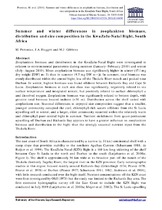Summer and winter differences in zooplankton biomass, distribution and size composition in the KwaZulu-Natal Bight, South Africa
Abstract
Zooplankton biomass and distribution in the KwaZulu-Natal Bight were investigated in relation to environmental parameters during summer (January–February 2010) and winter (July–August 2010). Mean zooplankton biomass was significantly higher in winter (17.1 mg dry weight [DW] m–3) than in summer (9.5 mg DW m−3). In summer, total biomass was evenly distributed within the central bight, low off the Thukela River mouth and peaked near Durban. In winter, highest biomass was found offshore between Richards Bay and Cape St Lucia. Zooplankton biomass in each size class was significantly, negatively related to sea surface temperature and integrated nitrate, but positively related to surface chlorophyll a and dissolved oxygen. Zooplankton biomass was significantly related to bottom depth, with greatest total biomass located inshore (<50 m). Distribution across the shelf varied with zooplankton size. Seasonal differences in copepod size composition suggest that a smaller, younger community occupied the cool, chlorophyll-rich waters offshore from the St Lucia upwelling cell in winter, and a larger, older community occurred within the relatively warm and chlorophyll-poor central bight in summer. Nutrient enrichment from quasi-permanent upwelling off Durban and Richards Bay appears to have a greater influence on zooplankton biomass and distribution in the bight than the strongly seasonal nutrient input from the Thukela River.

